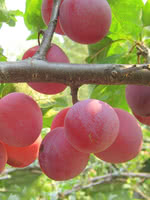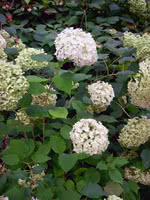Mon-Fri 9am - 5pm Mountain time
Pembina Plum vs Annabelle Hydrangea
Prunus nigra x salicina Pembina
Hydrangea arborescens Annabelle
Pembina Plum is one of the best-tasting plums that can be planted on the prairies. It is semi-freestone with orange flesh that is soft, juicy, and sweet which contrasts with the thick, sour, dark red skin. The plums can grow up to 5 cm in diameter and are well-suited for fresh eating, baking, and preserves.
They typically ripen in mid to late August and should be picked as soon as they are ripe. If left too long, the fruit will fall off the tree.
Pembina Plum is a hybrid between Canada Plum and Japanese Plum. For fruit production, it needs to be planted with another variety for cross-pollination. Canada Plum and American Plum are considered universal pollinizers.
Annabelle Hydrangea is a cold hardy shrub that is well known for its large, compact clusters of white flowers. Unlike other flowering species, Hydrangeas do best in partial shade. However, they are capable of growing in full sun if the soil is kept consistently moist.
Blooms occur on new wood, so regular pruning is encouraged in late winter. Try Annabelle Hydrangea as a border or on its own.

